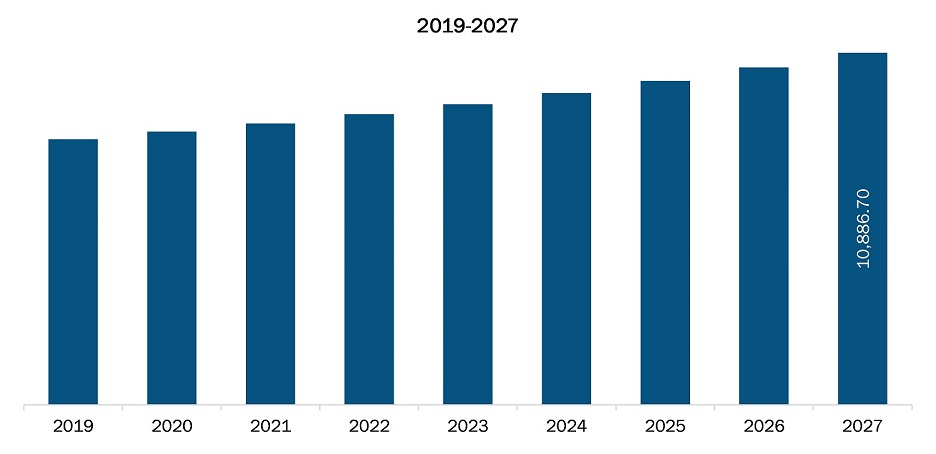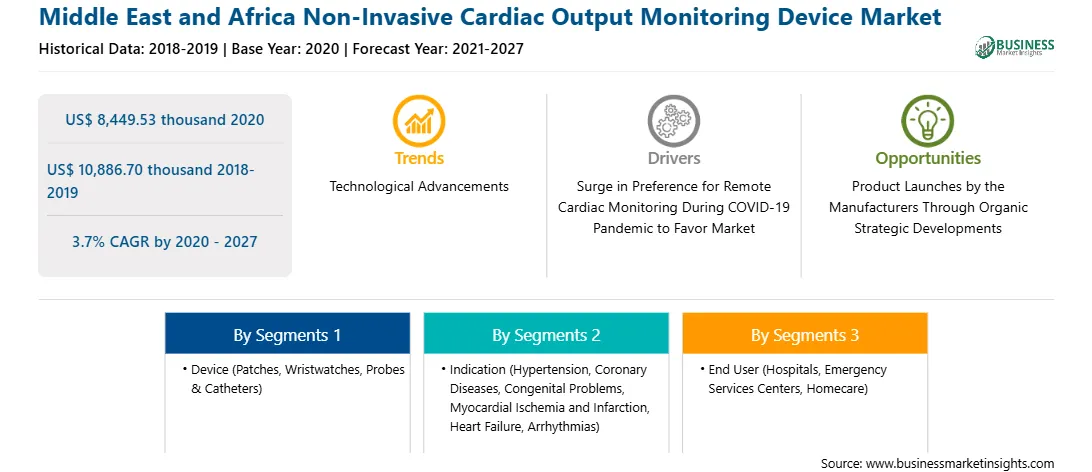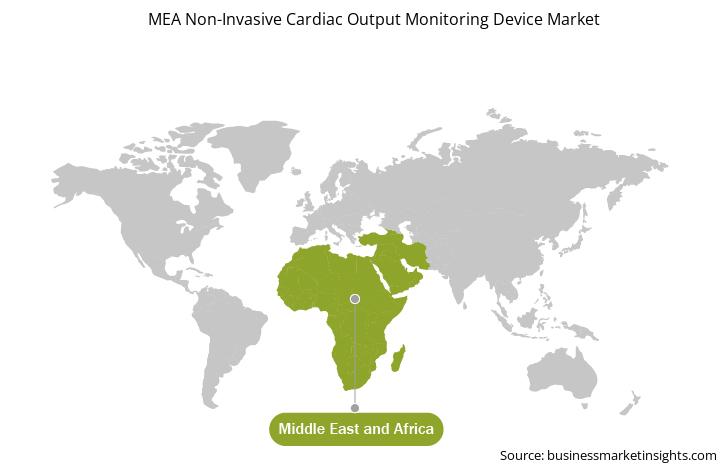Middle East and Africa Non-Invasive Cardiac Output Monitoring Device Market
No. of Pages: 129 | Report Code: TIPRE00022804 | Category: Life Sciences
No. of Pages: 129 | Report Code: TIPRE00022804 | Category: Life Sciences
The measurement of cardiac output (CO) is essential in medical practice. In the past, invasive monitoring with a pulmonary artery catheter (PAC) was the gold standard used to measure CO, but in recent years many minimally invasive or non-invasive devices have been developed to measure CO. Cardiac output gives information about tissue perfusion and oxygen delivery and can identify patients who are at high risk of mortality or morbidity.

Strategic insights for the Middle East and Africa Non-Invasive Cardiac Output Monitoring Device provides data-driven analysis of the industry landscape, including current trends, key players, and regional nuances. These insights offer actionable recommendations, enabling readers to differentiate themselves from competitors by identifying untapped segments or developing unique value propositions. Leveraging data analytics, these insights help industry players anticipate the market shifts, whether investors, manufacturers, or other stakeholders. A future-oriented perspective is essential, helping stakeholders anticipate market shifts and position themselves for long-term success in this dynamic region. Ultimately, effective strategic insights empower readers to make informed decisions that drive profitability and achieve their business objectives within the market.

| Report Attribute | Details |
|---|---|
| Market size in 2020 | US$ 8,449.53 thousand |
| Market Size by 2027 | US$ 10,886.70 thousand |
| Global CAGR (2020 - 2027) | 3.7% |
| Historical Data | 2018-2019 |
| Forecast period | 2021-2027 |
| Segments Covered |
By Device
|
| Regions and Countries Covered | Middle East and Africa
|
| Market leaders and key company profiles |
The geographic scope of the Middle East and Africa Non-Invasive Cardiac Output Monitoring Device refers to the specific areas in which a business operates and competes. Understanding local distinctions, such as diverse consumer preferences (e.g., demand for specific plug types or battery backup durations), varying economic conditions, and regulatory environments, is crucial for tailoring strategies to specific markets. Businesses can expand their reach by identifying underserved areas or adapting their offerings to meet local demands. A clear market focus allows for more effective resource allocation, targeted marketing campaigns, and better positioning against local competitors, ultimately driving growth in those targeted areas.

The Middle East and Africa non-invasive cardiac output monitoring device market is expected to reach US$ 10,886.70 thousand by 2027 from US$ 8,449.53 thousand in 2020; it is expected to grow at a CAGR of 3.7% from 2020 to 2027. The growth of the market is attributed to a few key driving factors such as rise in geriatric population, and development and launch of innovative monitoring devices. However, the high cost of the device hinders the market growth.
In recent years, many minimally invasive or non-invasive devices have been developed to measure cardiac output (CO), which is essential in a medical practice. Cardiac output gives information about tissue perfusion and oxygen delivery as well as can identify patients who are at high risk of mortality or morbidity. In addition, geriatric populations are susceptible to many chronic diseases. Most of them suffer from multiple diseases such as diabetes, heart diseases, and pulmonary diseases and some of them undergo surgeries. Non-invasive cardiac output (CO) monitoring is one of the important modern medical practices used while observing critically ill patients. As per the data from World Population Prospects: the 2019 Revision, 1 in 6 people in the world would be aged more than 65 by 2050, i.e., from 1 in 11 in 2019. Thus, the population with age 65 years and above is estimated to rise from 9% in 2019 to 16% by 2050. Thus, increasing geriatric population favours the growth of the Middle East and Africa non-invasive cardiac output monitoring device market. Also, many players operating in the market are focusing on developing and launching new products, as a part of their strategies to expand geographic reach and capacity to cater to many customers. Such developments and launches of new products are likely to emerge as a key market trend in the coming years.
Socio-economic condition in countries in Middle East is widely affected by the COVID-19 pandemic. Lockdown and social distancing are hindering access to work, regular income, payments, fairs, schools, and healthcare. Therefore, countries are undergoing huge losses and are trying to recover from them. However, the higher prevalence of heart disorders in the region supports the growth of the Middle East and Africa non-invasive cardiac output monitoring device market. Medical tourism is resuming owing to the bio-bubble agreements between different countries. It is expected that until the availability of vaccine in the region, the challenges are expected to continue for the market.
Based on device, the Middle East and Africa non-invasive cardiac output monitoring device market is segmented into patches, wristwatches, and probes & catheters. The probes & catheters segment held the largest share of the market in 2019. However, the wristwatches segment is estimated to register the highest CAGR in the market during the forecast period.
Based on indication, the Middle East and Africa non-invasive cardiac output monitoring device market is segmented into hypertension, coronary diseases, congenital problems, myocardial ischemia and infarction, heart failure, arrhythmias, and others. The hypertension segment held the largest share of the market in 2019. However, the heart failure segment is estimated to register the highest CAGR in the market during the forecast period.
Based on end user, the Middle East and Africa non-invasive cardiac output monitoring device market is segmented into hospitals, emergency services centers, homecare, and others. The hospitals segment held the largest share of the market in 2019. However, the emergency services centers segment is estimated to register the highest CAGR in the market during the forecast period.
Some of the primary and secondary sources associated with this report on the Europe non-invasive cardiac output monitoring device market are the Dubai Health Authority (DHA), Health Authority of Abu Dhabi (HAAD) and Saudi Heart Association (SHA).
The Middle East and Africa Non-Invasive Cardiac Output Monitoring Device Market is valued at US$ 8,449.53 thousand in 2020, it is projected to reach US$ 10,886.70 thousand by 2027.
As per our report Middle East and Africa Non-Invasive Cardiac Output Monitoring Device Market, the market size is valued at US$ 8,449.53 thousand in 2020, projecting it to reach US$ 10,886.70 thousand by 2027. This translates to a CAGR of approximately 3.7% during the forecast period.
The Middle East and Africa Non-Invasive Cardiac Output Monitoring Device Market report typically cover these key segments-
The historic period, base year, and forecast period can vary slightly depending on the specific market research report. However, for the Middle East and Africa Non-Invasive Cardiac Output Monitoring Device Market report:
The Middle East and Africa Non-Invasive Cardiac Output Monitoring Device Market is populated by several key players, each contributing to its growth and innovation. Some of the major players include:
The Middle East and Africa Non-Invasive Cardiac Output Monitoring Device Market report is valuable for diverse stakeholders, including:
Essentially, anyone involved in or considering involvement in the Middle East and Africa Non-Invasive Cardiac Output Monitoring Device Market value chain can benefit from the information contained in a comprehensive market report.